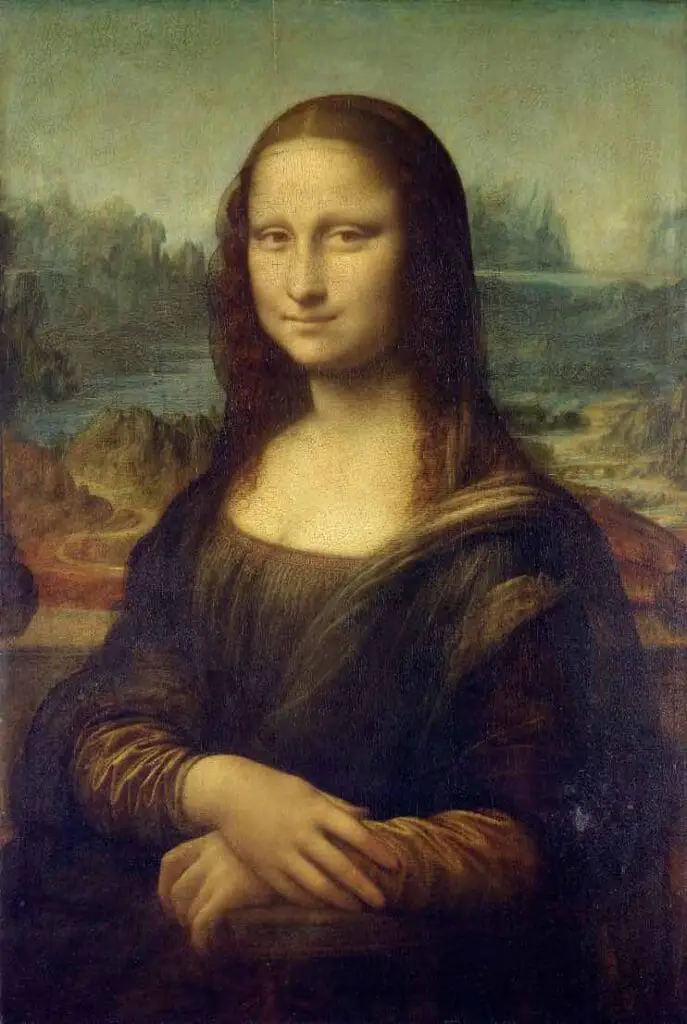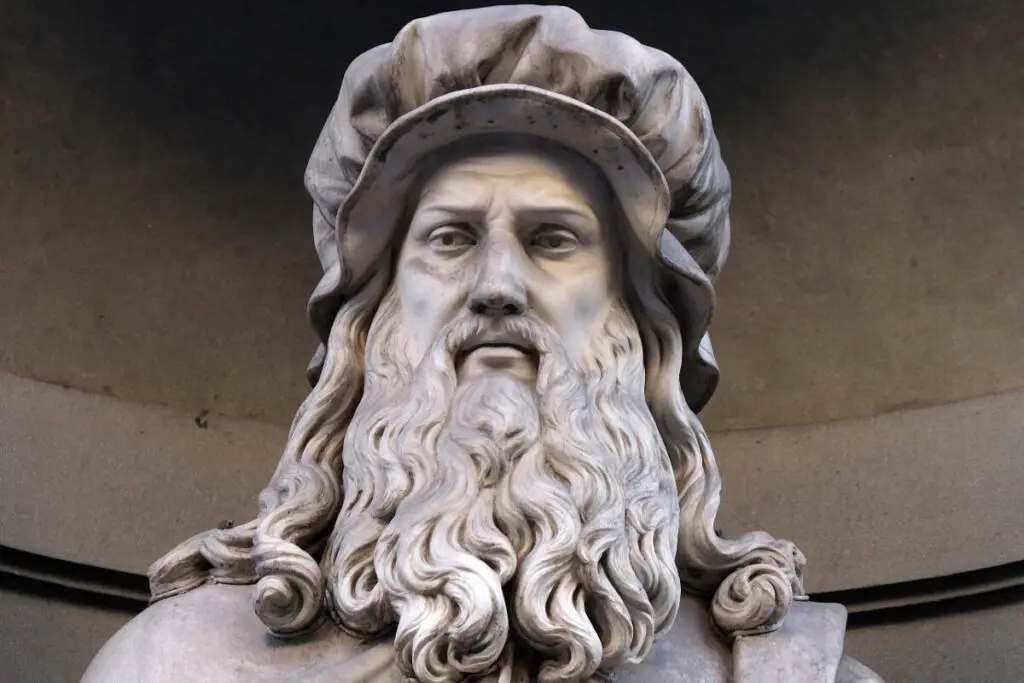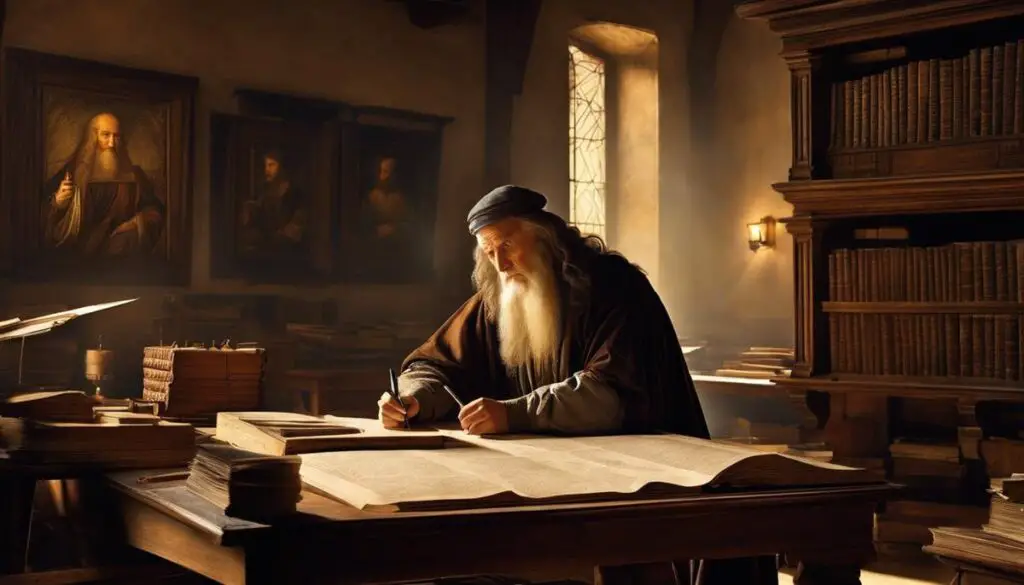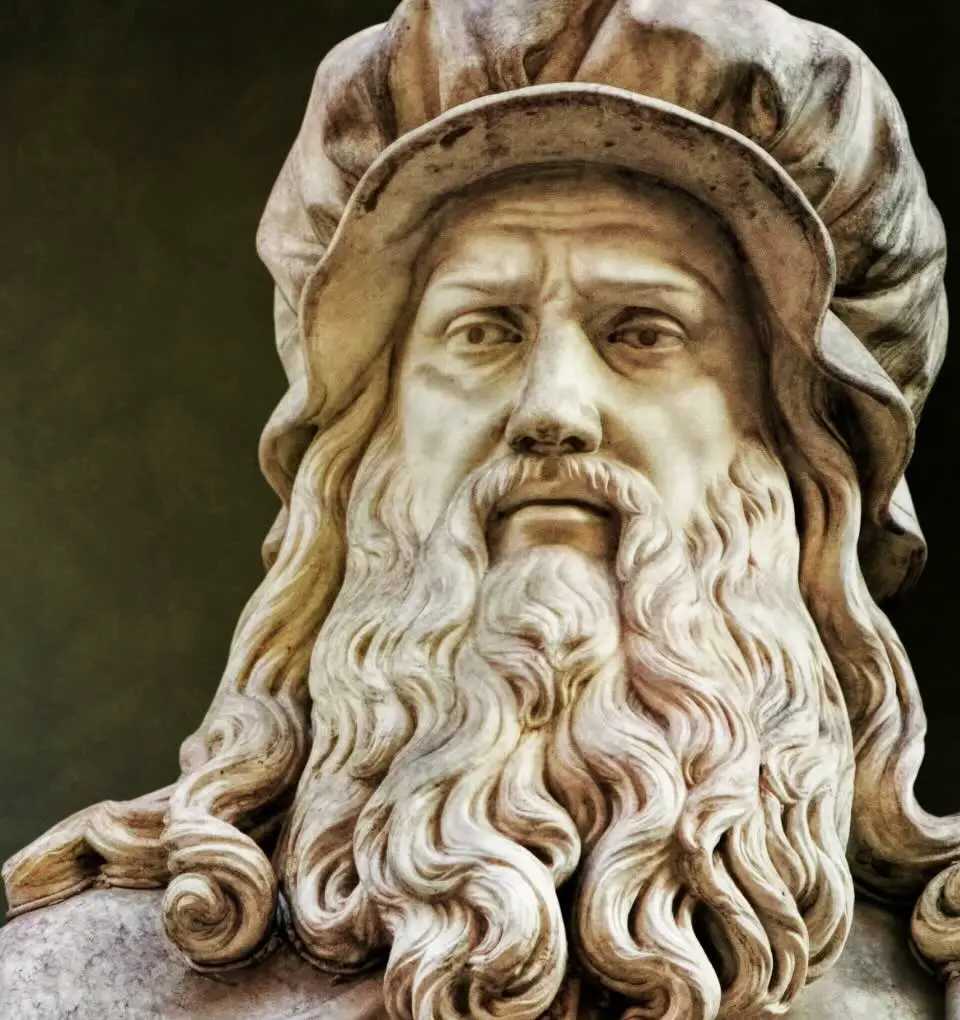Imagine a world where the same mind that conjures up the most iconic images in art is also the architect of visionary scientific concepts centuries ahead of their time. Leonardo da Vinci, a polymath of the Italian Renaissance, epitomized the term ‘Renaissance man’ with a voracity for knowledge and creativity that bridged the world of imagination with the mechanics of reality.
With life as a canvas, every brushstroke he made blended art and science, leaving a legacy that resonates through the echoes of the Mona Lisa’s enigmatic smile and the prescient sketches of flying machines. This essay explores the depth and breadth of Leonardo’s genius, revealing a man who saw no boundaries between art, nature, and the gears of the human body.
Table of Contents
- The Multifaceted Genius of Leonardo
- Leonardo’s Artistic Techniques and Influence
- The Notebooks of da Vinci: A Glimpse into a Renaissance Mind
- Related Questions
The Multifaceted Genius of Leonardo
The Multifaceted Genius of Leonardo da Vinci: Beyond the Brush
If one were to conjure an image of the quintessential Renaissance man, it would unmistakably mirror Leonardo da Vinci. A polymath of unparalleled talent, Leonardo’s genius sprawls across multiple disciplines, rendering him an eternal titan in the annals of human history. But what facets of his genius set him apart from his contemporaries and firmly cement his place as a historical figure nonpareil?

Firstly, consider the breadth and depth of Leonardo’s intellectual pursuits. While renowned for iconic paintings such as “The Last Supper” and the enigmatic “Mona Lisa,” his brilliance cannot be subdued within the frames of canvases.

His forays into anatomy, for instance, illustrate a fearless quest for knowledge and an impressive attention to detail. His anatomical sketches, informed by meticulous dissections, reveal insights centuries ahead, foreshadowing modern medical understandings.
Similarly, Leonardo’s investigations into the natural world showcase an overarching curiosity and keen observational prowess. His studies of botany, geology, and hydrodynamics demonstrate the comprehensive logic and systematic approach he applied to understanding and replicating the mechanisms of nature.
The accuracy with which he depicted plants, landscapes, and water flowing in his artworks cascades from this profound empirical engagement with the world around him.
But Leonardo’s genius was not tethered to observation alone; an incredibly inventive spirit also marked it. His codices are replete with designs of machines and gadgets that reveal the workings of an astonishingly innovative mind.
From flying contraptions and war machines to hydraulic pumps and bridges, Leonardo’s designs, though not always practical or realized in his lifetime, showed a mind that was perpetually engineering the future.
Equally important is Leonardo’s unparalleled mastery of artistry, particularly his pioneering techniques in rendering lifelike forms. His use of sfumato—a technique of allowing tones and colors to shade gradually into one another, producing softened outlines or hazy forms—contributed significantly to creating the atmospheric and emotive depth for which his masterpieces are celebrated.
His understanding of chiaroscuro, the treatment of light and shadow, gave his paintings a three-dimensional realism that was unparalleled at the time.
Another distinctive facet of Leonardo’s genius was the symbiosis he upheld between art and science. Unlike others who might have separated these domains, Leonardo advocated for a harmonious integration between scientific precision and artistic creativity.
His works defy the dichotomy typically ascribed to the analytic and the aesthetic, resulting in a holistic vision that resonates through his extensive oeuvre.
Symbolically, Leonardo’s notebook entries, written in his characteristic mirror script, exemplify not only his distinctive method of record-keeping but also the enigmatic nature of his intellect—simultaneously transparent and impenetrable, a puzzle that beckons scholars and admirers centuries after his passing.
Ultimately, Leonardo’s insatiable hunger for knowledge and his relentless investigation of the intricate tapestry of existence elevate him to a historical figure of boundless relevance.
His lifetime of achievements stands not merely as a testament to individual brilliance but as a beacon of human potential, illuminating the interconnectivity of all spheres of understanding.
The character of Leonardo da Vinci as a historical figure is etched into humanity itself; his genius, a reverberating echo across disciplines, continues to inspire and challenge the boundaries of imagination and what it means to create. In the dichotomy of the complexity and simplicity of his legacy, one finds the unparalleled facets of da Vinci—the artist, the scientist, the inventor, the visionary.
Leonardo’s Artistic Techniques and Influence
Leonardo da Vinci’s impact on art is as profound as eternal. This Renaissance master was not merely a painter of incomparable skill but a visionary whose approach to the canvas redefined the artist’s role as a conduit of beauty and truth.
A holistic understanding of nature, an unyielding quest for precision, and a profound grasp of human emotion are but a few of the elements that Leonardo melded into a revolutionary artistic methodology.
One cannot discuss Leonardo’s transformative impact on art without highlighting his pioneering use of sfumato. This subtle technique of blending colors and tones allowed for soft transitions between hues and marked a monumental leap from the bold lines of the early Renaissance.
Sfumato gave life to the Mona Lisa’s enigmatic smile and the contemplative gaze of St. John the Baptist, granting these works an otherworldly realism that continues to captivate and inspire.
Leonardo also brought the concept of chiaroscuro – the dramatic contrast between light and dark – to new heights, imbuing his paintings with a compelling three-dimensionality and sculptural firmness. The deep shadows and radiant highlights that dance across the folds of the Last Supper’s garments are testimony to a masterful manipulation of light that would echo through the corridors of art history.
Furthermore, Leonardo’s relentless pursuit of anatomical accuracy did not end with his numerous dissections. It colored his portrayal of the human form, breathing dynamic life into painted figures.
His exhaustive study of musculature and movement informed the poses and expressions of characters within his canvases, laying the groundwork for a nuanced representation of human anatomy that would become a hallmark of the High Renaissance and beyond.

The master’s attentiveness to landscape also signaled a dramatic shift in artistic technique. No longer mere backdrops, the landscapes in Leonardo’s paintings were rendered with attention to the interaction of light and atmosphere, setting a precedent for atmospheric perspective.
His dedication to depicting the harmonious relationship between humans and their environment would leave its mark on countless artists, from the rural backgrounds of Giorgione to the moody Dutch skies of Rembrandt.
Leonardo’s comprehensive practice extended to teaching as well. His treatise on painting, though posthumously compiled, brims with insights that had percolated through his own experiences and experiments.
He offered guidance on the technical intricacies of painting alongside profound reflections on an artist’s philosophical and moral duties. As a mentor to pupils like Gian Giacomo Caprotti (Salai) and Francesco Melzi, he imparted knowledge that would ripple through the studios of Europe, igniting fires of innovation in minds receptive to the siren call of art.
Thus, the quintessence of Leonardo’s artistic innovation lies in specific techniques and the ethos he brought forth. Art was no longer a mere craft to be learned but a field of endless inquiry, a mirror of the natural world, and a window into the human soul.
As his methodologies traversed the ages, influencing greats like Michelangelo and Raphael, one discerns a lineage of thought that values observant inquiry, empathetic rendering, and the pursuit of universal truth.
The connective thread of Leonardo’s influence is woven into the tapestry of art, each generation gleaning from it anew. His revolution in artistic methodology evidences the enduring power of intellect and talent unbound by convention—a clarion call for artists to perpetually seek, explore, and, above all, imagine.

The Notebooks of da Vinci: A Glimpse into a Renaissance Mind
Delving deeper into the treasure trove of insight provided by Leonardo da Vinci’s meticulously kept notebooks, one finds not just a visionary mind that leaped across disciplines but also a profound representation of the cultural and intellectual paradigms of the Renaissance.
These scattered pages are far from random musings; each line is a testament to the voracious curiosity that characterized the era.
Leonardo lived through a time when the medieval shackles were being unlocked — an epoch that embraced humanism and revivified the classical past. His sketches and notes encapsulate this transition, revealing a world bursting out of the theological confines of the Middle Ages into the enlightened radiance of the Renaissance.
The notebooks give us a front-row seat to witness the interplay among disciplines that today are unjustly siloed. For Leonardo, philosophy, engineering, the natural world, and art were merely different dialects of the same language of inquiry.

Within these aged pages, one discovers Leonardo’s fascination with proportion and symmetry, which is evident in his studies of the “Vitruvian Man.” Here, he engages with the works of ancient architects and mathematicians, like Vitruvius, translating their ideals into a visual form that marries art and geometry. These notes underscore the period’s quest for a mathematical order in the cosmos, reflective of a universe intelligible to man.
Leonardo’s observation of the world around him was not passive — it was an active, almost obsessive quest to distill the workings of nature into principles he could manipulate and harness.
For instance, his musings on the flow of water stretch from the tactile — designs for canals and bridges — to the contemplative, representing a microcosm of the world’s interconnectedness. This concept resonates with the holistic view adopted during the Renaissance.
The notebooks also chronicle the intellectual challenges of the time, such as the absence of formalized scientific methods. In Leonardo’s trial and error approach, one uncovers the embryonic stages of the scientific method. His willingness to test hypotheses to measure and revise ideas heralded a new mode of thought that would not fully fruition until the Scientific Revolution.
Moreover, Leonardo’s pages mirror his time’s social and political milieu. We glimpse the interactions with patrons like Ludovico Sforza, the delicate balancing act between commissioned work and personal exploration, and the competitive spirit that spurred creativity among contemporaries such as Michelangelo and Raphael.
In translating these historic revelations to a contemporary audience, one finds Leonardo’s notebooks more than diaries of a genius; they are a cultural artifact of a pivotal moment when humanity seemed to awake from a long slumber of unquestioned truths.
They are a vibrant testament to a time when the horizon of what was knowable expanded daily — and in no small part due to polymaths like Leonardo, who cast open the gates of discovery.
Though bereft of the colors that render his artworks immortal, the notebooks are a canvas where Leonardo painted in words and sketched the integration of art, science, and philosophy.
They are a microcosm of his mind, an era, and an artistic revolution that would forever redefine the potential of the human intellect and the expression of human creativity.

Leonardo da Vinci’s imprint on our world is indelible, transcending the passage of time and continuing to stir contemporary thought. His work remains a beacon of inspiration, not just in the hallowed halls of art and science, but as a testament to the boundless potential of human curiosity.
Science and art, often seen as disparate entities, were unified in Leonardo’s vision of the universe—a legacy that compels us to look beyond our horizons, challenge our assumptions, and cherish the awe from exploring the great tapestry of knowledge.
As we peer into the past to honor his contributions, we must also embrace the spirit of Leonardo, for it is within this spirit that our quest for understanding and innovation truly flourishes.
Anita Louise Art is dedicated to art education, great artists, and inspiring others to find and create their art. We love art that uplifts and inspires. #ArtToMakeYouSmile! #ArtToMakeYouHappy!
If you are interested to see any of my art, you can find out more by clicking here. If you are interested in what inspires me and my paintings, you can discover more by clicking here.
We have a free newsletter and would love you to be part of our community; you can subscribe to the newsletter by clicking here. I would be happy to talk to you if you have any questions. You can reach me, Anita, by clicking here.
Subscribe to our Anita Louise Art YouTube Channel filled with great videos and information by clicking here.
Join us for our podcast “5 Minutes With Art.” Spend 5 minutes a week with us to discover and learn about great art and artists. You can find out more about our podcast by clicking here.
Related Questions
How Was Leonardo da Vinci Able To Master So Many Different Professions?
Leonardo da Vinci is a man known to have had many different titles and professions during his lifetime. He was able to master this profession because he was a genius. But more than just being a genius, Leonardo is also self-educating and never stops learning. He had an insatiable amount of curiosity about all kinds of subjects.
By clicking here, you can learn more by reading How Was Leonardo da Vinci Able To Master So Many Different Professions?
What Can We Learn From Leonardo Da Vinci?
Leonardo da Vinci was a philosopher; being a philosopher means that you want to seek wisdom. Leonardo was one person who tried to seek knowledge or enlightenment in his life. Leonardo was an active observer and learner of the human body, human behavior, and nature.
By clicking here, you can learn more by reading What Can We Learn From Leonardo Da Vinci?
Was Leonardo da Vinci A Philosopher?
Leonardo da Vinci was a philosopher; being a philosopher means that you want to seek wisdom. Leonardo was one person who wanted to seek wisdom or enlightenment in his life. Leonardo was an active observer and learner of the human body, human behavior, and nature.
By clicking here, you can learn more by reading Was Leonardo da Vinci A Philosopher?


